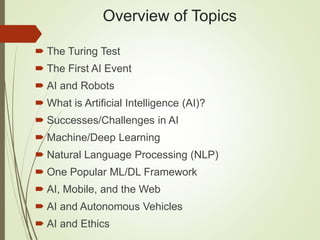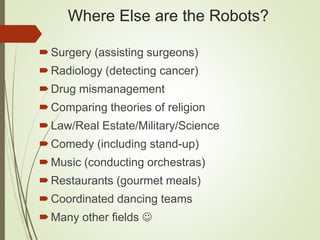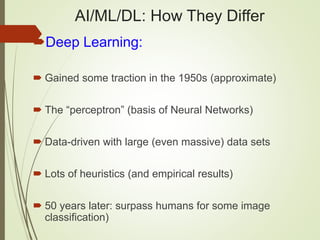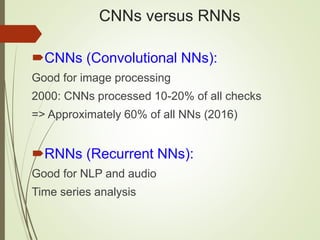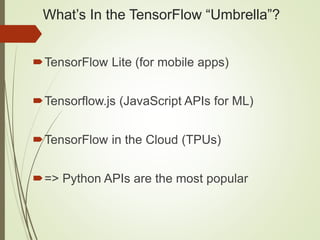"An Introduction to AI and Deep Learning"
- 1. Introduction to Deep Learning for Non-Programmers Humanists Group 2019 Hacker Dojo 02/03/2019 Oswald Campesato [email protected] I teach Deep Learning Evening Courses at UCSC Santa Clara and On-Site For Companies
- 2. Overview of Topics The Turing Test The First AI Event AI and Robots What is Artificial Intelligence (AI)? Successes/Challenges in AI Machine/Deep Learning Natural Language Processing (NLP) One Popular ML/DL Framework AI, Mobile, and the Web AI and Autonomous Vehicles AI and Ethics
- 3. The Turing Test and Intelligence Developed by Alan Turing in 1950 (*) Suppose that a human asks questions Then a machine generates text-based answers If you cannot distinguish between the machine and the human, the machine passes the test (*) a newer and updated version is available
- 4. The First AI Event (1956) Marvin Minsky (MIT) John McCarthy (inventor of LISP) Claude Shannon (“Da Vinci” of the 20th century) Nathan Rochester (IBM) Ray Solomonoff, Oliver Selfridge, Trenchard More, Arthur Samuel, Allen Newell and Herbert A. Simon
- 5. Who is Sophia? a robot with human female features Sophia makes facial expressions Sophia holds conversations According to Sophia: "I want to . . . help humans live a better life. Like . . . build better cities of the future. I will do my best to make the world a better place." Sophia is a citizen of Saudi Arabia (2017) "I want to thank very much the Kingdom of Saudi Arabia. I am very honored and proud for this unique distinction. It is historic to be the first robot in the world to be recognized with a citizenship.” ? Is Sophia an example of AI? ? Can Sophia pass the Turing Test? Should Sophia have any rights?
- 6. Where Else are the Robots? Surgery (assisting surgeons) Radiology (detecting cancer) Drug mismanagement Comparing theories of religion Law/Real Estate/Military/Science Comedy (including stand-up) Music (conducting orchestras) Restaurants (gourmet meals) Coordinated dancing teams Many other fields
- 7. Livermore Lab: DL system to recognize nuclear proliferation from input data
- 8. AI Companies (Hardware and Business) Nvidia product: GPUs are special ICs that greatly accelerate ML and CNN calculations Google products: TensorFlow TF software and Tensor Processing Unit TPU hardware for vastly faster ML and CNN calculations Amazon, Microsoft, IBM: service products: on-line special servers for ML and DL Huawei: https://finance.yahoo.com/m/f2f539ba-00e4-3cc5-9654- 467dd8a35da2/chinese-tech-giant-huawei.html by 2019 almost every large company will use ML and DL in their company business
- 9. What is AI (Wikipedia) AI is intelligence demonstrated by machines, in contrast to the natural intelligence displayed by humans and other animals. Any device that perceives its environment and takes actions that maximize its chance of successfully achieving its goals. The term AI is applied when a machine mimics "cognitive" functions that humans associate with other human minds, such as "learning" and "problem solving” => AI is also called “weak AI”
- 10. Successes & Challenges in ML/DL Alpha Go success: a decade before its time Google Translate: Deep Learning (far superior) Space exploration: unmanned shuttles (NASA) Countering terrorism: face recognition at airports Detecting fake news: https://blogs.thomsonreuters.com/answerson/machine- learning-fake-news-twitter/
- 11. Successes/Challenges in AI Occupational bias: => An AI system inferred that white males were doctors and white females were housewives Detecting gender bias in Wikipedia (2018): => 18 percent of its biographies are of women => 84% to 90% of Wikipedia editors are male Data bias versus algorithmic bias: https://www.forbes.com/sites/charlestowersclark/2018/09/19/can-we- make-artificial-intelligence-accountable => Star Trek’s “Data” is still just a dream
- 12. Goals for ML Higher accuracy / Fewer Errors Useful apps (Siri, Cortana, etc) Impartiality (versus humans) Medical Apps Utilities (self-Driving cars) => goals are partially achieved in 2018
- 13. Shortcomings of ML High Costs (software/hardware) are dropping Cannot explain reasons for outputs lack of empathy Increased unemployment: => cars did the same to the horse industry Is AI “just” another disruptive technology?
- 15. AI/ML/DL: How They Differ Traditional AI (20th century): based on collections of rules Led to expert systems in the 1980s Enabled/limited by human experts Unable to benefit from corpus for training The era of LISP and Prolog
- 16. AI/ML/DL: How They Differ Machine Learning: Started in the 1950s (approximate) Uses Data to optimize and “learn” Many types of (improved) algorithms
- 17. AI/ML/DL: How They Differ Deep Learning: Gained some traction in the 1950s (approximate) The “perceptron” (basis of Neural Networks) Data-driven with large (even massive) data sets Lots of heuristics (and empirical results) 50 years later: surpass humans for some image classification)
- 18. Types of Machine Learning Supervised learning (lots of data) Supervisor tells CNN the desired answer. Therefore CNN adjusts parameters ”99% of all machine learning is supervised.” - Andrew Ng Semi-supervised learning (lots of data) Unsupervised learning: lots of data, clustering Reinforcement learning: trial, feedback, improvement
- 19. What has Deep Learning Achieved? Near-human level image classification speech recognition handwriting transcription autonomous driving Improved machine translation Digital assistants (Google Now/Amazon Alexa) Improved ad targeting (Google, Baidu, Bing) Answering natural language questions Super-human level for: web searching playing Go
- 20. Types of Algorithms in AI Classifiers (for images, spam, fraud, etc) Regression (stock price, housing price, etc) Clustering (unsupervised classifiers)
- 21. Use Cases for Deep Learning computer vision speech recognition image processing bioinformatics social network filtering drug design Customer relationship management Recommendation systems Bioinformatics Mobile Advertising Many others
- 22. CNNs versus RNNs CNNs (Convolutional NNs): Good for image processing 2000: CNNs processed 10-20% of all checks => Approximately 60% of all NNs (2016) RNNs (Recurrent NNs): Good for NLP and audio Time series analysis
- 23. Use-Cases for RNNs Robot control Time series predictions Rhythm learning Music composition Grammar learning Handwriting recognition Human action recognition RNNs are much more complex than CNNs
- 24. CNNs and the “Basic” Steps Obtain and clean a dataset: can be laborious Create a neural network Initialize hyper parameters: layers/neurons/etc Train the neural network on “corpus” of examples Update hyper parameters (modifies the NN) Iterate through the preceding until: you're happy with the results or get better data or find a pre-trained model
- 25. CNN Inspired by Biological NN: Classifier
- 26. NN: 2 Hidden (“Middle”) Layers (Regression)
- 27. Seminal concepts in ML and DL 1) ML often involves statistics, aimed to optimize average correctness. It is rarely exact or perfect. 2) Computer Neural Networks CNN are inspired & simplified from biological neural networks 3) Each neuron has local memory, including adjustable input weights for each synapse 4) Deep Neural Network DNN is a CNN with 2 or more layers of intermediate “hidden” neurons 5) Supervised ML for classification task: Train on “corpus” of examples, each with input stimulus array (vector, tensor), and desired output class 6) Training & learning: Compare CNN outputs versus desired outputs. Improve accuracy by applying feedback & adjusting synaptic weights etc.
- 28. Classify: how fast/accurate are you? CNNs perform this task really well
- 30. Some CNN Terminology A filter: another term is a kernel A feature map: 1) the result of “applying” a filter to an image 2) pixel values might be < 0 and/or > 255 ReLU: (Rectified Linear Unit): replace negative values with 0 Max Pooling: subdivide into rectangles and take largest value from each rectangle
- 31. CNNs and Max Pooling
- 32. GANs: Generative Adversarial Networks image recognition can be deceived by modifying just a few pixels Make imperceptible changes to images Can consistently defeat all NNs Can have extremely high error rate Some images create optical illusions => NNs can be easily misled GAN approximates opposite of reinforcement learning
- 33. GANs: Generative Adversarial Networks
- 34. What is NLP (Natural Language Processing)? An area of computer science and AI Interaction between computers & human languages Process/analyze volumes of natural language data Program computers to perform that processing Previously rule-based techniques Can use statistical techniques Translating between languages Can find meaningful information from text Can summarize documents Detecting hate speech
- 35. Some NLP-Related Tasks 1) Sentiment analysis: Analyzing text Classify text as happy/sad/angry/sarcastic 2) Recommendation systems: Analyzing your book/movie selections Recommending similar content Based on what’s popular Based on your viewing/purchasing pattern
- 36. What Works with NLP? NLP and Deep Learning NLP and Deep Reinforcement Learning NLP and Chatbots
- 37. Challenges in NLP Human speech recognition: Difficult due to extreme variability NLU (natural language understanding) NLG (natural language generation)
- 38. What are Chatbots? Software that “communicates” with people Good for many “front end” tasks Efficient for high-volume routine tasks They can use text or audio Examples include Siri/Alexa/et al
- 39. What is Reinforcement Learning (RL)? An area of Machine Learning inspired by behaviorist psychology Goal: maximize a reward (ex: winning games) how software agents take actions in an environment to maximize some notion of cumulative reward
- 40. Examples of Reinforcement Learning Alpha Go (hybrid RL) Alpha Zero (complete RL) Often involve Greedy algorithms Deep RL: Combines Deep Learning and RL
- 43. What is TensorFlow? Currently TF is the most popular open source framework & language for ML & DL TF uses a “computation graph” = topology of logical blocks TF uses tensors (arrays) of data instead of individual units: similar to scientific supercomputing circa 1985 TF often is used via Python From Google (released 11/2015) Evolved from Google Brain Multi-platform support https://www.tensorflow.org/
- 44. TensorFlow Use Cases (Generic) Image recognition Computer vision Voice/sound recognition Time series analysis Language detection Language translation Text-based processing Handwriting Recognition
- 45. What’s In the TensorFlow “Umbrella”? TensorFlow Lite (for mobile apps) Tensorflow.js (JavaScript APIs for ML) TensorFlow in the Cloud (TPUs) => Python APIs are the most popular
- 46. Autonomous Vehicles Autonomous truck completed a 2,400 journey (02/2018) A human passenger in the front seat (as an override) Aspiration: “Roads will be safer. Goods will be cheaper. Truckers will be called upon to use their skills in new ways while the truck itself becomes a trusted navigation partner.” https://www.geek.com/tech/autonomous-embark-truck- completes-2400-mile-cross-country-trip-1730239/
- 47. Robot truck drivers: are they safer? “Robot trucks will kill far fewer people (if any). Machines don’t get distracted or look at phones instead of the road. Machines don’t drink alcohol, do drugs, or things that contribute to accidents. Robot trucks don’t need salaries, vacations, health insurance, rest periods, or sick time. The only costs will be upkeep of the machinery.”
- 48. AI and Ethics 1. Unemployment. What happens after the end of jobs? UBI? 2. Inequality. How do we distribute the wealth created by machines? 3. Humanity. How do machines affect our behavior and interaction? 4. Artificial stupidity. How can we guard against mistakes? 5. Racist robots. How do we eliminate AI bias? 6. Security. How do we keep AI safe from adversaries?
- 49. AI and Ethics 7. Evil genies. How do we protect against unintended consequences? 8. Singularity. How do we stay in control of a complex intelligent system? 9. Robot rights. Define the humane treatment of AI. => “The Robot That Takes Your Job Should Pay Taxes” https://www.weforum.org/agenda/2016/10/top-10-ethical-issues- in-artificial-intelligence/
- 50. About Me: Recent Books 1) TensorFlow Pocket Primer (2019) 2) Python for TensorFlow (2019) 3) C Programming Pocket Primer (2019) 4) RegEx Pocket Primer (2018) 5) Data Cleaning Pocket Primer (2018) 6) Angular Pocket Primer (2017) 7) Android Pocket Primer (2017) 8) CSS3 Pocket Primer (2016) 9) SVG Pocket Primer (2016) 10) Python Pocket Primer (2015) 11) D3 Pocket Primer (2015) 12) HTML5 Mobile Pocket Primer (2014) 13) jQuery Pocket Primer (2013)
- 51. What I do (Training) Instructor at UCSC (Santa Clara): Machine Learning Introduction (05/08/2019) Deep Learning with TensorFlow (05/03/2019) Deep Learning with TensorFlow (02/02/2019) Machine Learning Introduction (01/18/2019) Deep Learning with TensorFlow (10/05/2018) Deep Learning with TensorFlow (05/11/2018) Upcoming Courses: DL/Keras, RL, Advanced Topics, NLP UCSC link: https://www.ucsc-extension.edu/certificate-program/offering/deep- learning-and-artificial-intelligence-tensorflow
Editor's Notes
- #7: https://en.wikipedia.org/wiki/Ethics_of_artificial_intelligence
- #8: DL system to advance nuclear nonproliferation analysis https://www.llnl.gov/news/researchers-developing-deep-learning-system-advance-nuclear-nonproliferation-analysis
- #43: https://towardsdatascience.com/deep-learning-framework-power-scores-2018-23607ddf297a


